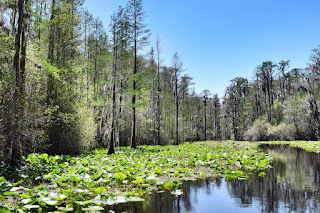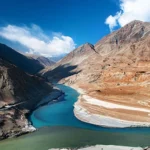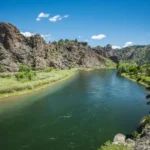
The Okefenokee Swamp is a 700-square-mile wetland in the United States, located in the state of Georgia’s south-eastern corner, along the Florida/Georgia border. The swamp is thought to have formed around 6,500 years ago, when peat accumulated in the shallow basin. The name ‘Okefenokee’ is thought to have come from the indigenous Creek people who lived in the area. It is thought to mean ‘Waters Shaking,’ rather than the original translation of ‘Land of Trembling Earth,’ which was previously thought to be correct. Cypress swamps, floating peat mats, winding natural waterways, shrubs, forests, and a high sand ridge can all be found in the Okefenokee Swamp.
Interesting facts about Okefenokee Swamp:
The Okefenokee National Wildlife Refuge and Okefenokee Wilderness protect the majority of Okefenokee Swamp from human destruction.
The Okefenokee Swamp is the largest blackwater swamp in North America. A blackwater swamp is one that has been darkly stained by vegetation decay, giving it the appearance of black tea or coffee.
Okefenokee Swamp was designated a National Natural Landmark in 1974.
Swampers are people who have lived in the Okefenokee Swamps region for a long time.
The Okefenokee Swamp is home to a wide variety of wildlife, including birds, reptiles, and amphibians. The swamp region is home to approximately 400 vertebrate species, 60 reptile species, and 200 bird species.
The Okefenokee Swamp is home to a large number of American alligators.
The Okefenokee Swamp is home to the Florida black bear, as well as herons, egrets, bitterns, cranes, woodpeckers, toads, frogs, snakes, turtles, and lizards.
The Okefenokee Swamp has 120 miles of water trails for boaters and paddlers to enjoy. The majority of the swamp is 2 to 10 feet deep.
Beginning in 1910, the Okefenokee Swamp was logged for its very old cypress, red bay, and pine trees for nearly 25 years. President Franklin D. Roosevelt put a stop to it in 1937 by prohibiting logging in the area.
It is estimated that 400,000 tourists visit Okefenokee Swamp each year.
The Suwannee Sill Recreation Area in Fargo, Stephen C. Foster State Park in Fargo, Kingfisher Landing in Race Pond, and Suwannee Canal Recreation Area in Folkston are the four public entrances to the Okefenokee Swamps.
Visitors to the Okefenokee Swamps can also gain access near Waycross, Georgia, at the privately owned Okefenokee Swamp Park.
DuPont abandoned their mineral rights in the area in 2000. They had planned a titanium mining operation that would last 50 years, but government protests and opposition forced them to donate the land. The Okefenokee National Wildlife Refuge received 7000 acres of the 16,000 acres donated, while The Conservation Fund kept the rest.
Wildfires have ravaged Okefenokee Swamp in recent years, most notably in 2007, when two wildfires merged and burned more than 600,000 acres in the area. The Bugaboo Scrub Fire was the name given to this fire.
In 2011, a new fire broke out, scorching much of the area once more.










Thank you for writing such a helpful and informative article! Your insights and guidance have been instrumental in helping me better understand the topic. I was wondering if you have any additional related content that you could recommend? I would love to continue learning and exploring this subject further. Thank you again for sharing your knowledge and expertise with your readers!